3.1 Introducing Nonfiction
| Site: | Cowichan Valley School District - Moodle |
| Course: | ELA5, CSS, Sferrazza |
| Book: | 3.1 Introducing Nonfiction |
| Printed by: | Guest user |
| Date: | Monday, 15 December 2025, 12:10 AM |
Learning Target
By the end of this lesson, you should be able to say YES to the following questions.
- Can I tell the difference between fiction and nonfiction forms of text?
- Do I know the different purposes of fiction and nonfiction forms of text?
- Can I identify different genres of nonfiction text?

Introduction
On average, 80% of the reading adults do outside of school is nonfiction. Surprising, isn’t it! Let’s take a closer look.
What is fiction?
“Fiction” refers to literature created from the imagination.
- Mysteries, science fiction, adventure, fantasy, and realistic fiction are all fiction genres.
- It's purpose is to entertain.
- Fiction books all have one main structure - beginning, middle, and end.
- Fiction needs to be read in order.
- Fiction has story elements - character, setting, plot, conflict, and often a theme.
What is nonfiction?
Everything else is non-fiction – which means based in fact. It is the biggest category of reading, writing, and viewing, too. It includes many categories including biography, business, cooking, health and fitness, pets, crafts, home decorating, languages, travel, home improvement, religion, art and music, history, self-help, science, and more.
- It's purpose is to learn or teach - inform, explain, instruct, describe.
- It can be read in any order.
- It has text features you will be learning more about.
Look around your house. What nonfiction can you find? Walk around right now and try this. Don’t turn the page until you do.
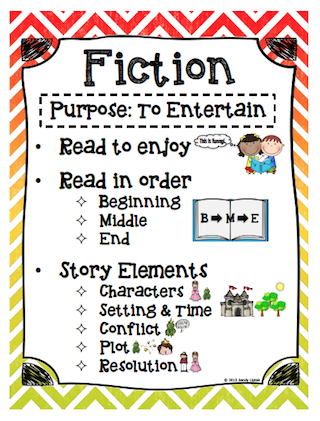
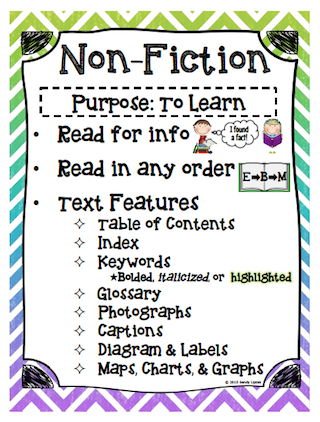
Categorize
Categorize the following as fiction or nonfiction:
|
Recipe
Fairy tale
Map
Novel
Manual for Xbox
To-do List
|
Getting Rid of Ants Pamphlet
Newspaper Article
Newsletter
Ingredients on food packing
Harry Potter novel
Biography of Justin Trudeau
|
Nonfiction Text Structures
As you could tell from the previous page, there are many kinds of nonfiction texts. Here are five categories:
Descriptive – Describe or tell about something (a ladybug, a country).
Instructional – Give instructions on how to do or make something. Usually in chronological order (ordered from first to last). May be numbered or use words like first, next, then, finally. Can have diagrams or pictures. Gives necessary detail and few extra details. Also known as procedural as step-by-step procedures are given.
Explanatory – Tell how or why something happens. Often uses cause and effect language – because, if, therefore. May have technical vocabulary. (how rainbows are formed, why leaves change colour, or why snakes shed their skins)
Persuasive – Try to convince you to do something, buy something, or go somewhere. Tell you what to do and try to convince you to do that. Might try to convince with words or pictures.
Biography – Tell the events of a real person (birth, family, childhood, adulthood, significant contribution to the world). May have quotations, may be lively in tone. Often in chronological (ordered from first to last)

Your Task
On the next five pages in this online book, you will find descriptions of actual books. Your task is to determine what "category" of nonfiction text each book best fits. After you've tried out the categories in this online book, look at nonfiction text in your home - recipe books, manuals, magazines, travel books, school textbooks... Can you figure out what category each of those would be? Following this lesson will be a quiz.
(Credits: The book descriptions were adapted from amazon.ca and the book cover pictures are also from amazon.ca)
Type 1
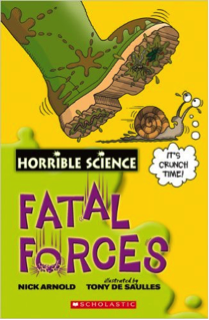
Which type of non-fiction is the following book? Descriptive, instructional, explanatory, persuasive, or biography?
Horrible Science - Fatal Forces by Nick Arnold -
For those who can stomach the squeamish side of science! Why and how do your ears stop you from falling off your bike? How could a little bit of gravity make you lose your head? What exactly can make your fillings explode? In this volume, the Horrible Science team takes on the forces of physics!
Type 2
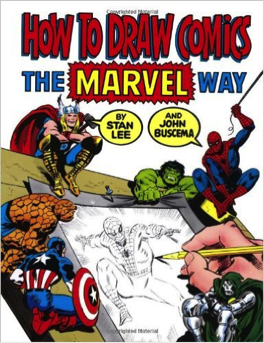
Which type of nonfiction is the following book? Descriptive, instructional, explanatory, persuasive, or biography?
How To Draw Comics The Marvel Way by Stan Lee
One of the first and still one of the best, Stan Lee’s How to Draw Comics the Marvel Way has been the primary resource for any and all who want to master the art of illustrating comic books and graphic novels.
Stan Lee, the Mighty Man from Marvel, and John Buscema, active and adventuresome artist behind the Silver Surfer, Conan the Barbarian, the Mighty Thor and Spider-Man, have collaborated on this comics compendium. Using artwork from Marvel comics as primary examples, Buscema graphically illustrates the mysterious methods of comic art. How to Draw Comics the Marvel Way belongs in the library of everyone who has ever wanted to illustrate his or her own comic strip.
Type:
Type 3
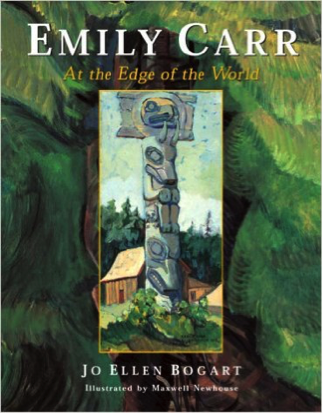
Which type of nonfiction is the following book? Descriptive, instructional, explanatory, persuasive, or biography?
Emily Carr At The Edge of the World by Jo Ellen Bogart
The brilliant artist Emily Carr lived at the edge. When she was born, in 1871, Victoria, British Columbia was a small, insular place. She was at the edge of a society that expected well-bred young ladies to marry. For years, she was at the edge of the world of artists she longed to join.
Emily Carr’s life was not an easy one. She struggled against a family that did not approve of her art and against poor health. She found her pleasures in her many pets. Later, she would meet the artists of the Group of Seven and among them find her soul mates.
When illness put a stop to her painting, she found expression and comfort in her writing. Her book Klee Wyck received Canada’s highest literary honor – the Governor General’s Award. This is her life story.
Type:
Type 4
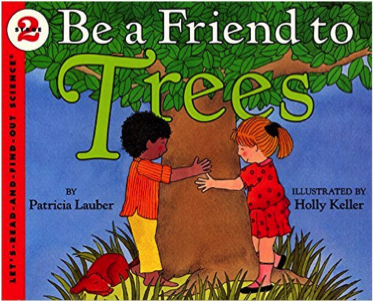
Which type of nonfiction is the following book? Descriptive, instructional, explanatory, persuasive, or biography?
Be A Friend To Trees By Patricia Lauber
Why should you be a friend to trees? This book will try to convince you of their importance.
Trees are a valuable natural resource. People depend on trees for food, and animals depend on trees for food and shelter. But most important, we depend on trees because they add oxygen, a gas we all need, to the air. While trees give us many wonderful products, we must also protect them because we can't live without them.
Type:
Type 5
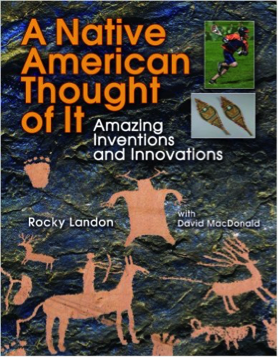
What type of nonfiction is the following book? Descriptive, instructional, explanatory, persuasive, or biography?
A Native American Thought of It by Rocky Landon and David Macdonald
Everyone knows that moccasins, canoes and toboggans were invented by the Aboriginal people of North America, but did you know that they also developed their own sign language, as well as syringe needles and a secret ingredient in soda pop?
Depending on where they lived, Aboriginal communities relied on their ingenuity to harness the resources available to them. Some groups, such as the Iroquois, were particularly skilled at growing and harvesting food. From them, we get corn and wild rice, as well as maple syrup.
With photos and information-packed text, this book explores eight different categories in which the creativity of First Nations peoples from across the continent led to remarkable inventions and innovations, many of which are still in use today.
Type:
Reflection
What did you learn today?
- Fiction books have one main text structure - beginning, middle, and end.
- There are several different forms of nonfiction: descriptive, instructional, explanatory, persuasive, biography.
- Being able to identify forms of text can help us with our understanding of nonfiction books.
Can you find examples of different nonfiction forms in your house?